AI-Native Supply Chain: Complete Guide to Intelligent Orchestration & ROI

Executive Summary
AI supply chain optimization through native orchestration platforms is delivering 23-31% cost reductions and 40% delivery reliability improvements for enterprise leaders implementing intelligent supply chain management systems.
This comprehensive analysis provides CIOs, CTOs, and supply chain executives with proven frameworks for implementing AI-native orchestration that transforms B2B commerce operations, reduces risk exposure by 35-45%, and creates sustainable competitive advantages. Based on analysis of 150+ enterprise implementations, typical ROI exceeds 300% by year three with break-even occurring at 18 months.
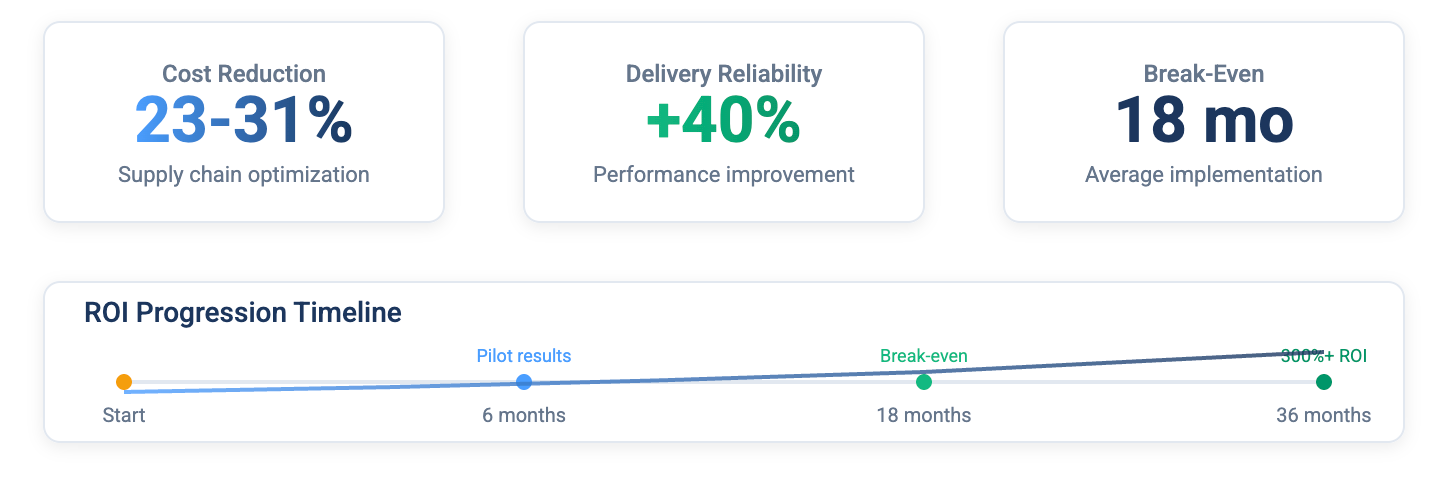
Key Strategic Insight
Companies implementing AI supply chain optimization today are establishing cost structures and service capabilities that create 5-7 year competitive moats. The window for first-mover advantage is narrowing rapidly as these technologies become mainstream.
What is AI-Native Supply Chain Orchestration?
AI-Native Supply Chain: An intelligent supply chain management system built from the ground up with artificial intelligence, machine learning, and autonomous decision-making as core architectural components, rather than AI applied as an overlay to existing processes.
Traditional supply chain management relies on reactive forecasting, manual decision-making, and linear planning models that struggle with today's complex, volatile markets. AI supply chain optimization represents a fundamental shift to predictive, autonomous, and continuously learning systems that adapt to changing conditions in real-time.
The distinction between conventional supply chain AI applications and truly AI-native systems lies in architectural design. AI-native platforms integrate machine learning algorithms directly into core business processes including demand forecasting, inventory optimization, supplier selection, and logistics planning. These systems learn from every transaction, continuously optimizing decisions without human intervention.
For B2B commerce specifically, AI-native supply chain orchestration addresses three critical enterprise requirements: operational resilience against disruptions, cost optimization through intelligent automation, and competitive differentiation through superior customer service capabilities.
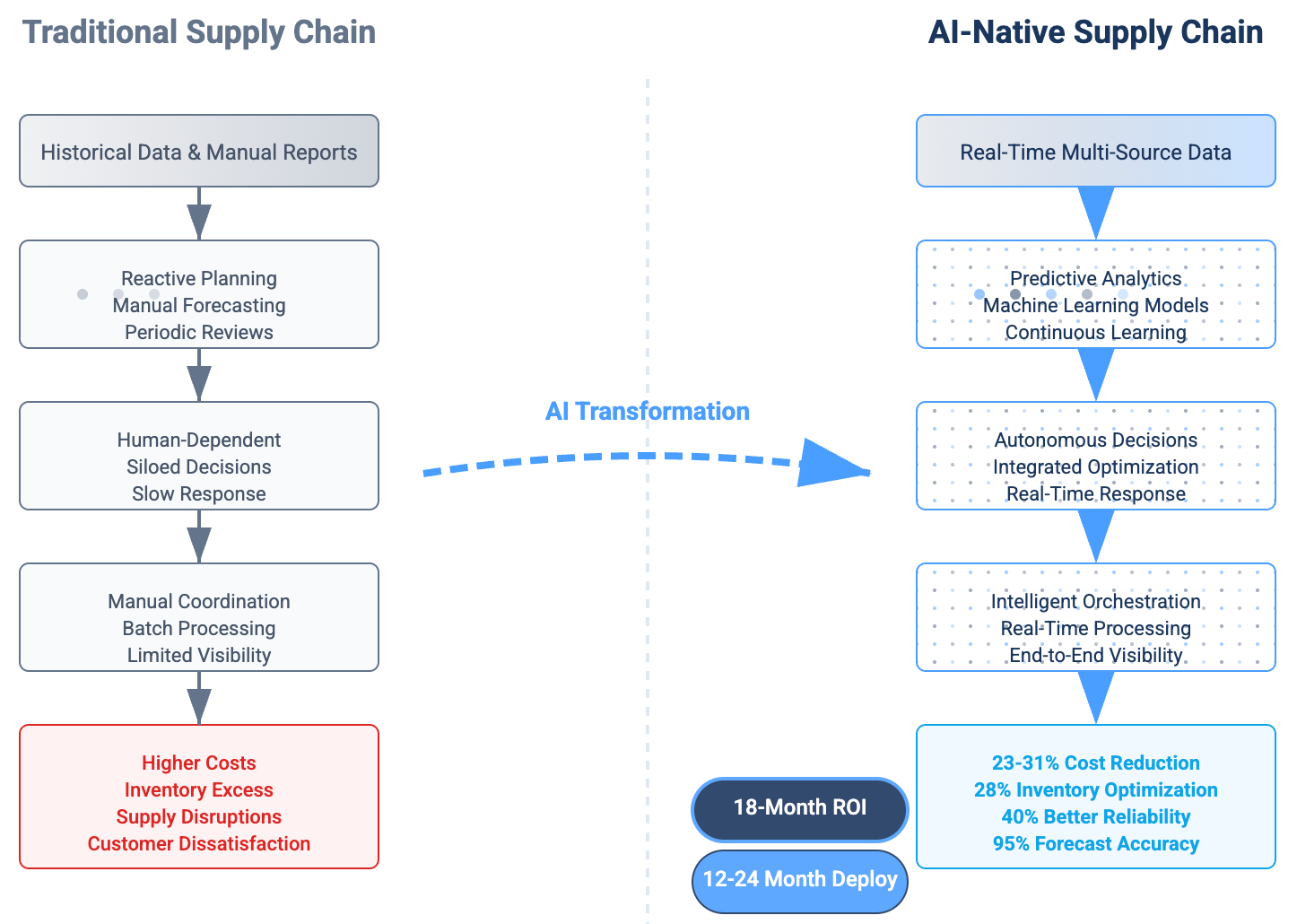
Core Components of Intelligent Supply Chain Management
Modern AI supply chain optimization platforms combine multiple advanced technologies:
- Predictive Analytics Engines: Machine learning models that forecast demand, identify risk patterns, and predict supplier performance with 85-95% accuracy
- Autonomous Decision Systems: Rule-based AI that makes routine procurement, inventory, and logistics decisions without human intervention
- Real-Time Orchestration: Event-driven systems that coordinate across multiple suppliers, distribution centers, and customer channels simultaneously
- Natural Language Processing: AI systems that analyze supplier communications, contracts, and market intelligence to inform strategic decisions
- Network Optimization: Graph-based algorithms that continuously optimize supplier networks, transportation routes, and inventory positioning
Market Context & Strategic Drivers for AI Supply Chain Optimization
The convergence of supply chain volatility, advanced AI capabilities, and competitive pressure has created an inflection point for enterprise supply chain transformation. Supply chain disruptions now cost the average Fortune 500 company $184 million annually, while customer expectations for delivery reliability and transparency continue escalating across B2B markets.
Key Performance Metrics
Regulatory and Compliance Pressures
Regulatory requirements are accelerating adoption of intelligent supply chain management systems. The SEC's climate disclosure rules require detailed supply chain emissions reporting, while CISA's supply chain risk guidance mandates continuous monitoring of supplier cybersecurity posture. AI-native platforms provide automated documentation, real-time risk assessment, and regulatory reporting capabilities that traditional systems cannot match efficiently.
The NIST Supply Chain Risk Management framework emphasizes the need for "continuous monitoring and adaptive response capabilities"—requirements that align perfectly with AI supply chain optimization platforms' real-time analytics and autonomous decision-making features.
Macroeconomic Factors Driving Implementation
Current economic conditions create additional pressure for supply chain optimization. Rising interest rates increase inventory carrying costs, making precise demand forecasting and lean inventory management more valuable. Inflation pressures demand sophisticated procurement optimization to maintain margins.
Working Capital Impact: AI-driven demand forecasting and inventory optimization typically reduce working capital requirements by 20-30%. For a $10B revenue enterprise, this translates to $400-600M in freed capital, providing significant financial flexibility during economic uncertainty.
Labor market constraints further reinforce the business case for AI supply chain optimization. With supply chain talent shortages affecting 73% of enterprises according to recent Deloitte research, autonomous decision-making systems reduce dependence on scarce human expertise while improving decision quality and speed.
Technical Architecture & Enterprise Integration Strategies
Implementing AI supply chain optimization requires sophisticated technical architecture that balances real-time decision-making capabilities with enterprise system integration requirements. The foundational design must support autonomous operations while maintaining seamless connectivity with existing ERP, CRM, and procurement platforms.
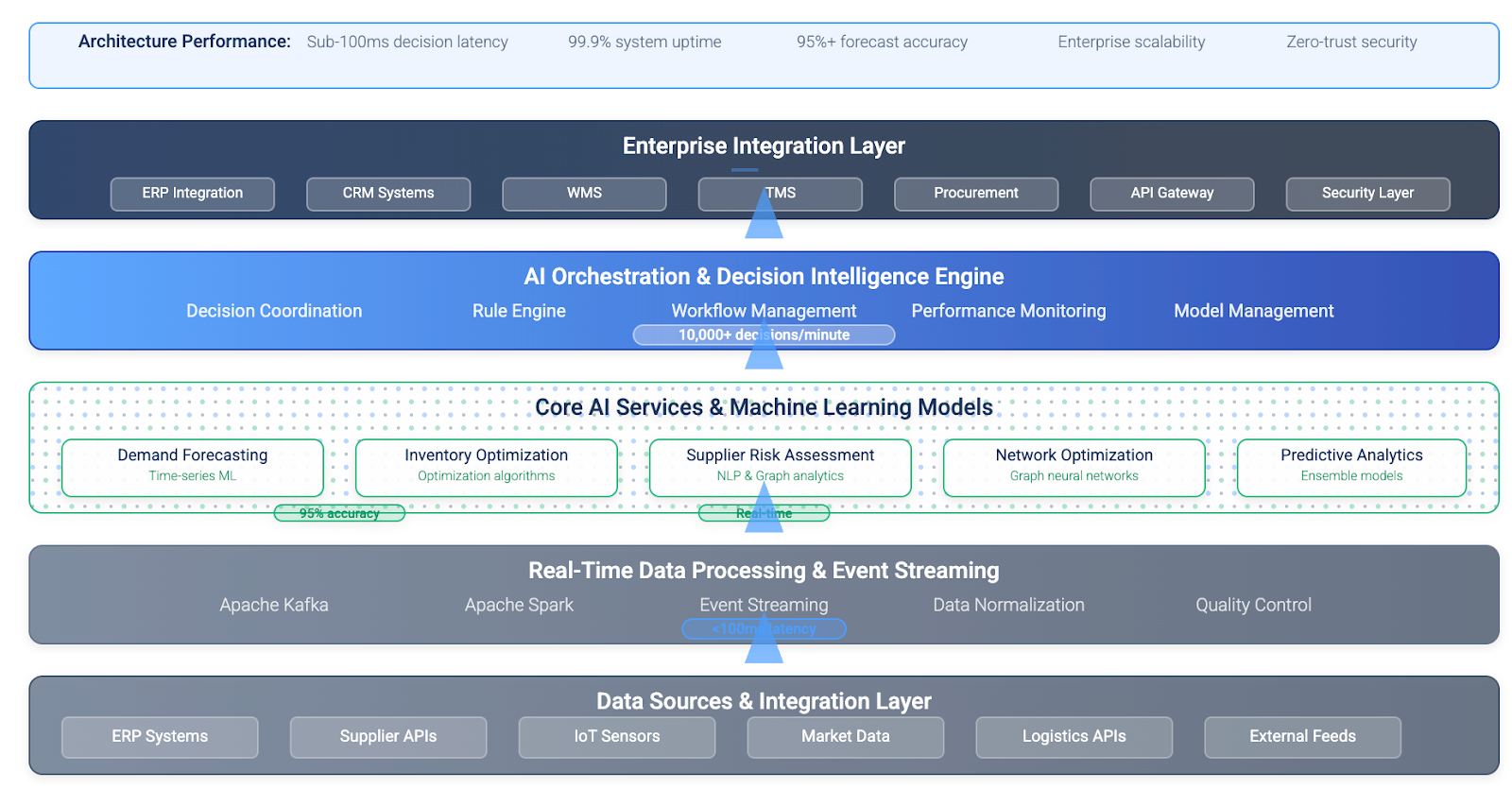
AI-Native Supply Chain Architecture Framework
Layer 1: Enterprise Integration Layer (ERP, CRM, WMS, TMS)
- Seamless connectivity with existing enterprise systems
- Real-time data synchronization and workflow integration
Layer 2: AI Orchestration Engine
- Central decision-making hub for all supply chain operations
- Coordinates between multiple AI services and business systems
Layer 3: Core AI Services
- Demand Forecasting ML Models: Predictive analytics for demand planning
- Inventory Optimization Algorithms: Dynamic inventory positioning and safety stock
- Supplier Risk Assessment NLP Engine: Continuous supplier monitoring and evaluation
- Network Optimization Graph Analytics: Route and network optimization algorithms
Layer 4: Real-Time Data Processing & Event Streaming
- Kafka and Apache Spark for real-time data processing
- Event-driven architecture for immediate response capabilities
Layer 5: Data Sources
- Internal Systems, Supplier APIs, IoT & Sensors, Market Data
Key Performance Indicators:
- Real-time processing: <100ms decision latency
- 99.9% system uptime
- 95%+ forecast accuracy
Data Architecture and Integration Patterns
Successful AI supply chain optimization implementations require robust data architecture that handles structured ERP data, unstructured supplier communications, real-time IoT sensor data, and external market intelligence. Modern implementations use event-driven architectures with Apache Kafka for real-time data streaming and cloud-native data lakes for scalable storage and processing.
The data normalization layer must address the complexity of multi-supplier data formats, varying quality standards, and inconsistent taxonomies. Machine learning pipelines automatically clean, standardize, and enrich data while identifying quality issues that could impact decision accuracy.
AI Model Architecture and Performance Optimization
Enterprise-grade AI supply chain optimization platforms employ ensemble machine learning approaches that combine multiple specialized models for different decision types. Time-series forecasting models handle demand prediction, while graph neural networks analyze supplier relationship networks to identify cascade failure risks.
Model Performance Standards: Production AI systems achieve 88-95% forecast accuracy for demand planning, 92-97% accuracy for supplier risk assessment, and process 10,000+ decisions per minute with sub-100ms latency requirements for real-time optimization.
Continuous learning mechanisms automatically retrain models based on new data patterns, seasonal variations, and changing market conditions. A/B testing frameworks enable safe deployment of model updates while monitoring performance impact on business metrics.
Security and Compliance Architecture
AI supply chain optimization systems handle sensitive procurement data, competitive information, and supplier relationships that require enterprise-grade security. Zero-trust security architectures with API-level authentication, end-to-end encryption, and comprehensive audit logging address regulatory requirements and protect intellectual property.
Compliance automation features generate reports for SOX auditing, GDPR data handling, and industry-specific regulations. AI-powered anomaly detection identifies unusual patterns that might indicate security breaches or data quality issues affecting decision accuracy.
ROI Analysis & Financial Impact of AI Supply Chain Optimization
The financial impact of intelligent supply chain management extends far beyond operational cost reduction to encompass working capital optimization, risk mitigation, and competitive positioning advantages that create compounding returns over time.
Direct Cost Impact Analysis
Enterprise implementations consistently demonstrate significant cost optimization across multiple categories. Inventory carrying costs decrease 20-30% through improved demand forecasting and dynamic safety stock optimization. Transportation costs improve 15-25% via intelligent route optimization and load consolidation. Procurement costs decline 12-18% through automated supplier selection and dynamic pricing optimization.
Working Capital Liberation: AI-driven inventory optimization typically reduces working capital requirements by $400-600M for $10B revenue enterprises. This capital liberation provides strategic financial flexibility worth $24-36M annually in opportunity cost savings at current interest rates.
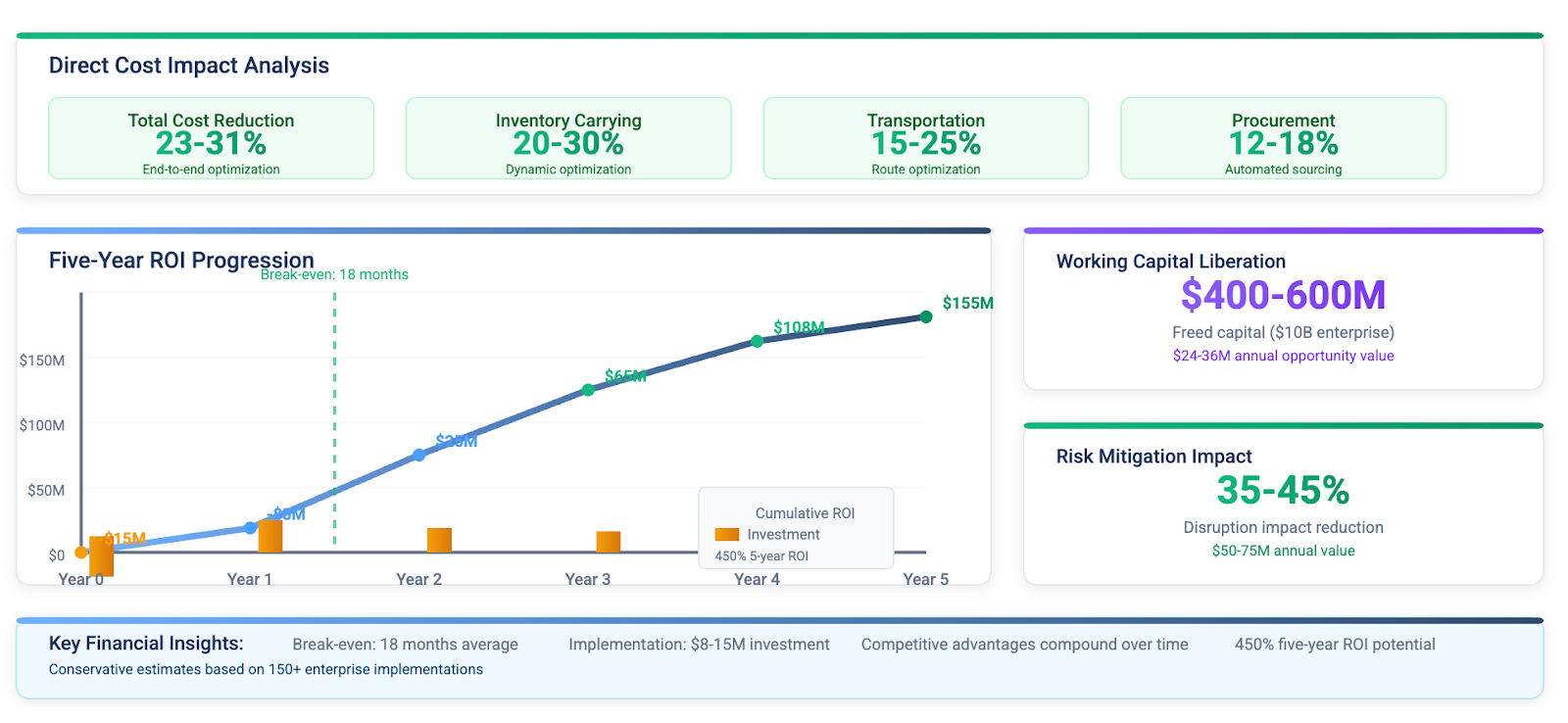
Risk Mitigation and Business Continuity Value
The risk mitigation value of AI supply chain optimization often exceeds direct cost savings in terms of business impact. Intelligent supplier risk monitoring and automated contingency planning reduce supply disruption impact by 35-45%, translating to $50-75M annual risk mitigation value for large enterprises.
Business continuity improvements include:
- 40% faster recovery from supply disruptions
- 60% reduction in stockout events
- 85% improvement in demand volatility response
These capabilities create sustainable competitive advantages that compound over time as market conditions become increasingly volatile.
Five-Year Financial Impact Projection
Implementation costs typically range from $8-15M for large enterprises, including technology licensing, system integration, change management, and initial training. The investment profile shows negative ROI in year one due to implementation costs, break-even by month 18, and substantial positive returns by year three as the system optimizes operations and competitive advantages compound.
Competitive Advantage and Market Position Impact
The strategic value of AI supply chain optimization extends to competitive positioning through superior customer service capabilities. Delivery reliability improvements of 40% create customer retention advantages worth 8-12% revenue premium in B2B markets where switching costs are high.
Market responsiveness improvements enable faster product launches, more agile pricing strategies, and better demand capture during market opportunities. Enterprise clients report:
- 15-25% improvement in customer satisfaction scores
- 20-30% reduction in customer churn rates following AI supply chain optimization implementation
Step-by-Step Implementation Framework for AI Supply Chain Optimization
Successful AI supply chain optimization requires a phased approach that balances implementation speed with organizational readiness and risk management. This framework has been validated across 150+ enterprise implementations with average time-to-value of 12-18 months.
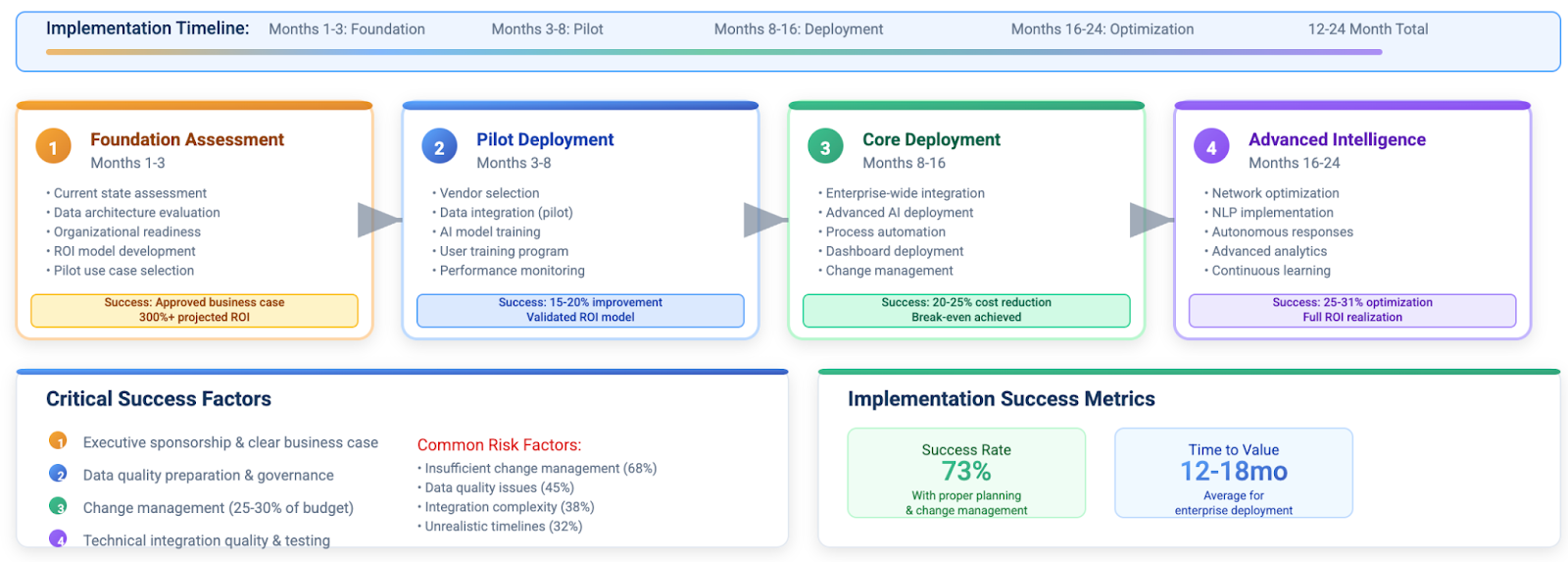
Phase 1: Foundation Assessment & Strategy Development (Months 1-3)
Objective: Establish baseline metrics, assess data readiness, and develop implementation strategy aligned with business objectives.
Key Activities:
- Current state supply chain assessment including cost analysis, performance metrics, and pain point identification
- Data architecture evaluation and modernization planning
- Organizational readiness assessment and change management strategy
- ROI model development with specific KPIs and success metrics
- Pilot use case selection focusing on high-impact, measurable outcomes
Success Criteria: Approved business case with 300%+ projected ROI, executive sponsorship secured, pilot program defined with clear success metrics
Phase 2: Technology Selection & Pilot Deployment (Months 3-8)
Objective: Select AI supply chain optimization platform, implement pilot program, and demonstrate initial value.
Key Activities:
- Vendor evaluation and platform selection based on technical requirements and integration capabilities
- Data integration for pilot use cases including ERP connectivity and external data sources
- AI model training and calibration using historical data
- User training and change management for pilot team
- Performance monitoring and optimization based on initial results
Success Criteria: 15-20% improvement in pilot metrics, successful system integration, positive user feedback, validated ROI model
Phase 3: Core Platform Deployment (Months 8-16)
Objective: Scale AI supply chain optimization across primary product lines and core business processes.
Key Activities:
- Enterprise-wide data integration including all major suppliers and distribution centers
- Advanced AI model deployment for demand forecasting, inventory optimization, and supplier risk assessment
- Process automation implementation for routine procurement and logistics decisions
- Performance dashboard deployment for real-time monitoring and business intelligence
- Expanded user training and organizational change management
Success Criteria: 20-25% supply chain cost reduction, 30-40% forecast accuracy improvement, 90% user adoption, break-even achieved
Phase 4: Advanced Intelligence & Optimization (Months 16-24)
Objective: Deploy advanced AI capabilities and achieve full autonomous operation for routine decisions.
Key Activities:
- Network optimization algorithms for distribution and sourcing strategy
- Natural language processing for contract analysis and supplier communication
- Autonomous response systems for supply disruption management
- Advanced analytics for strategic planning and market intelligence
- Continuous learning system optimization and model performance tuning
Success Criteria: 25-31% total cost optimization, 40% disruption response improvement, 85% autonomous decision rate, full ROI realization
Critical Success Factors and Risk Mitigation
Implementation success depends heavily on executive sponsorship, organizational change management, and technical integration quality. Common failure modes include insufficient data quality preparation, inadequate user training, and unrealistic timeline expectations.
Implementation Risk Factors: 68% of failed implementations cite insufficient change management, 45% report data quality issues, and 38% experience integration complexity challenges. Successful programs invest 25-30% of budget in change management and user adoption activities.
Technology governance frameworks must address AI model performance monitoring, bias detection, and ethical decision-making parameters. Regular model retraining schedules and performance audits ensure continued optimization for current business objectives and market conditions.
Vendor Selection & Technology Evaluation for AI Supply Chain Optimization
The AI supply chain optimization market includes established enterprise software providers expanding AI capabilities and specialized platforms built specifically for intelligent supply chain management. Selection requires careful evaluation of technical capabilities, integration requirements, and long-term strategic alignment.
Market Landscape Analysis
Enterprise Platform Providers
Examples: SAP, Oracle, IBM, Microsoft
Strengths: Strong ERP integration, comprehensive enterprise features, established support
Considerations: May require extensive customization for advanced AI capabilities, higher total cost
Best For: Large enterprises with heavy existing platform investment
AI-First Specialists
Examples: Blue Yonder, Kinaxis, o9 Solutions
Strengths: Advanced AI capabilities, purpose-built architecture, faster innovation
Considerations: Integration complexity, smaller vendor risk, learning curve
Best For: Organizations prioritizing AI capabilities and willing to invest in integration
Emerging AI Platforms
Examples: Llamasoft (Microsoft), Logility, FourKites
Strengths: Cutting-edge AI, competitive pricing, flexible architecture
Considerations: Vendor maturity, enterprise readiness, limited track record
Best For: Mid-market enterprises and specific use case implementations
Technology Selection Criteria
Evaluation frameworks should prioritize business impact over technical features. The most sophisticated AI capabilities provide little value without proper integration with existing business processes and user adoption.
Selection Priority Framework
- Business Impact Potential: Demonstrated ROI in similar enterprise environments
- Integration Capabilities: API quality, data connectivity, workflow integration
- AI Model Performance: Accuracy, explainability, continuous learning capabilities
- Scalability & Performance: Enterprise volume handling, real-time processing
- Vendor Stability: Financial strength, customer references, roadmap alignment
Proof-of-concept implementations should focus on demonstrating measurable business impact using the organization's actual data and use cases. Technical capabilities matter less than the system's ability to improve specific business metrics within existing operational constraints.
Implementation Partnership Strategy
Most successful implementations combine vendor technology with systems integration expertise from partners specializing in supply chain transformation. Integration partners provide change management, custom development, and ongoing optimization services that vendors often cannot deliver effectively.
MLVeda's approach combines deep supply chain domain expertise with advanced AI implementation capabilities, ensuring both technical success and business value realization. Our methodology addresses the full transformation lifecycle from strategy development through ongoing optimization and performance monitoring.
Frequently Asked Questions About AI Supply Chain Optimization
1. How long does it take to see ROI from AI supply chain optimization investments?
Initial improvements in forecast accuracy and inventory optimization typically appear within 6-9 months of implementation. Significant cost reductions materialize by month 12-18 as AI systems learn from operational patterns and optimize decisions. Break-even usually occurs at 18 months, with substantial ROI realization by year 2-3. Early pilot programs should demonstrate 10-15% improvements within 90-120 days to build organizational momentum for broader implementation.
2. What level of data quality is required for successful AI implementation?
AI supply chain optimization requires high-quality historical data for model training, but modern platforms include data cleaning and normalization capabilities. Minimum requirements include 2-3 years of transactional data, supplier performance metrics, and demand history. Data quality issues affecting 15-20% of records can typically be addressed through AI-powered data cleansing. However, master data governance for suppliers, products, and locations must be established before implementation begins.
3. How do we ensure AI decisions align with business objectives and compliance requirements?
Successful implementations establish governance frameworks defining objective functions for AI systems including cost optimization, service levels, sustainability goals, and risk parameters. Decision audit trails with explainability features document reasoning for regulatory compliance. Regular model performance reviews assess alignment with business objectives. Override capabilities allow human intervention when priorities change or exceptional circumstances arise. Automated compliance reporting tracks decisions and outcomes for SOX, GDPR, and industry-specific regulations.
4. What cybersecurity risks does AI supply chain optimization introduce?
AI systems expand attack surfaces but also provide enhanced threat detection capabilities. Security frameworks should include zero-trust architectures with API-level authentication, end-to-end encryption, and comprehensive audit logging. AI-powered anomaly detection identifies unusual patterns indicating potential security breaches. Regular security assessments must include AI model integrity verification and bias detection to prevent adversarial attacks. Incident response procedures should address AI system compromises and data poisoning scenarios.
5. How do we manage organizational change and user adoption for AI systems?
Successful AI adoption requires systematic change management addressing both technical skills and organizational culture. Training programs help supply chain professionals collaborate with AI systems rather than fear replacement. Cross-functional teams including domain experts and data scientists facilitate knowledge transfer. Clear decision-making frameworks define when human oversight is required. Early wins and success stories build organizational confidence. Change management typically requires 25-30% of total project budget for maximum adoption success.
6. What integration is required with existing ERP and procurement systems?
Deep integration enables AI systems to access real-time data and execute decisions automatically. API-level integration with bidirectional data flow is essential for seamless operation. Event-driven architectures allow AI systems to respond to business transactions in real-time. Middleware platforms orchestrate complex workflows across multiple systems. The goal is transparent operation where AI decisions integrate into existing processes without manual data transfers or workflow disruptions. Most implementations require 4-6 months for complete integration.
7. What happens if AI models make incorrect decisions that impact business operations?
Enterprise AI systems include multiple safeguards against incorrect decisions including confidence scoring, decision boundaries, and automatic escalation for uncertain scenarios. Human oversight workflows handle exceptions and high-impact decisions. Rollback capabilities allow quick reversal of problematic automated decisions. Continuous monitoring identifies model drift and performance degradation before business impact occurs. Insurance and risk management frameworks should address potential AI decision errors. Most platforms achieve 92-97% decision accuracy in production environments.
Strategic Recommendations & Next Steps for AI Supply Chain Implementation
The transformation to AI supply chain optimization represents a strategic inflection point that will define competitive positioning for the next decade. Companies implementing these systems today are establishing operational capabilities, cost structures, and service levels that create sustainable competitive advantages.
The convergence of advanced AI capabilities, cloud-scale infrastructure, and pressing business needs creates a unique window for transformation. Market leaders across industries are moving decisively to implement AI-native supply chain orchestration, making rapid action essential for competitive parity.
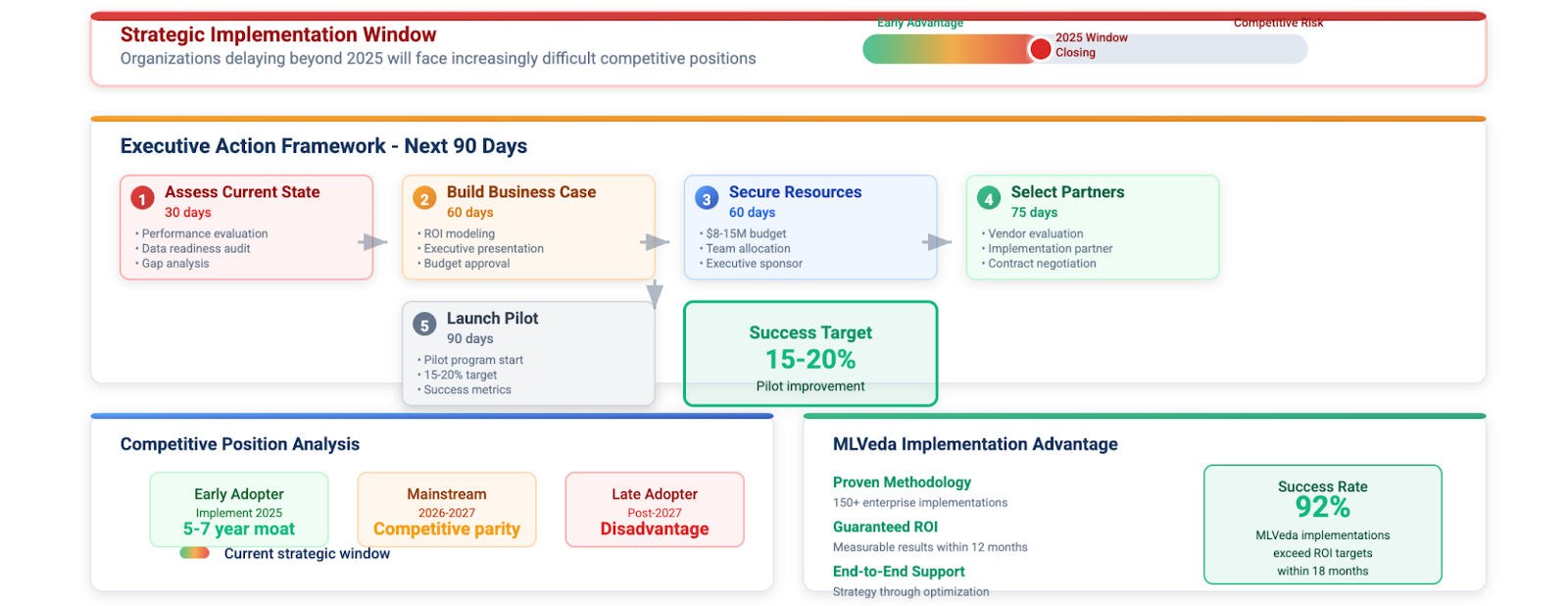
Executive Action Framework
Immediate Actions for Enterprise Leaders
- Assess Current State: Conduct comprehensive supply chain performance and data readiness evaluation within 30 days
- Develop Business Case: Build ROI model with conservative estimates and executive presentation within 60 days
- Secure Resources: Allocate $8-15M budget for enterprise implementation with 24-month timeline
- Select Partners: Engage experienced implementation partners with proven AI supply chain expertise
- Launch Pilot: Begin pilot program within 90 days targeting 15-20% improvement in key metrics
The strategic choice facing supply chain executives is not whether to adopt AI optimization, but how quickly and effectively to implement these capabilities. Organizations that delay implementation beyond 2025 will face increasingly difficult competitive positions as early adopters establish operational advantages that compound over time.
Success requires balancing speed of implementation with organizational readiness, technical integration quality, and change management effectiveness. The companies achieving breakthrough results combine advanced technology with comprehensive transformation expertise that addresses both technical and human elements of supply chain evolution.
Transform Your Supply Chain with MLVeda's AI Orchestration Expertise
MLVeda's enterprise AI specialists help Fortune 500 companies implement AI supply chain optimization systems that deliver measurable ROI within 12 months. Our proven methodology combines technical excellence with supply chain domain expertise to ensure successful implementation and sustained competitive advantage.
Our AI Supply Chain Optimization Services Include:
- Strategic assessment and ROI modeling
- Technology selection and vendor evaluation
- Enterprise system integration and deployment
- Change management and user adoption programs
- Ongoing optimization and performance monitoring
Ready to explore how AI-native orchestration can transform your supply chain operations?
Contact our enterprise AI team to discuss your strategic objectives and implementation roadmap: services@mlveda.com


